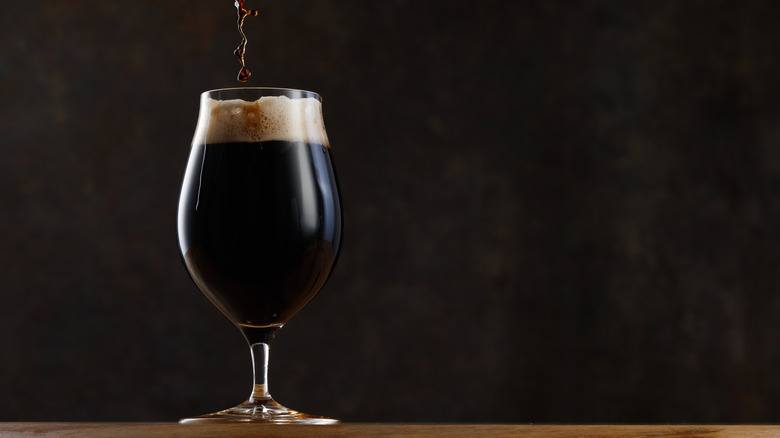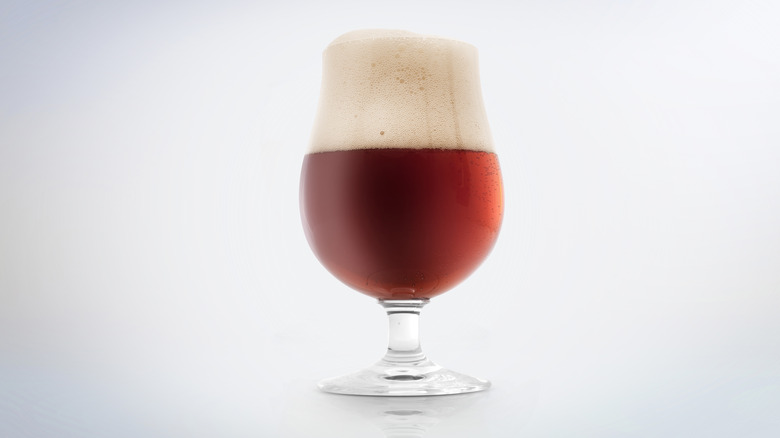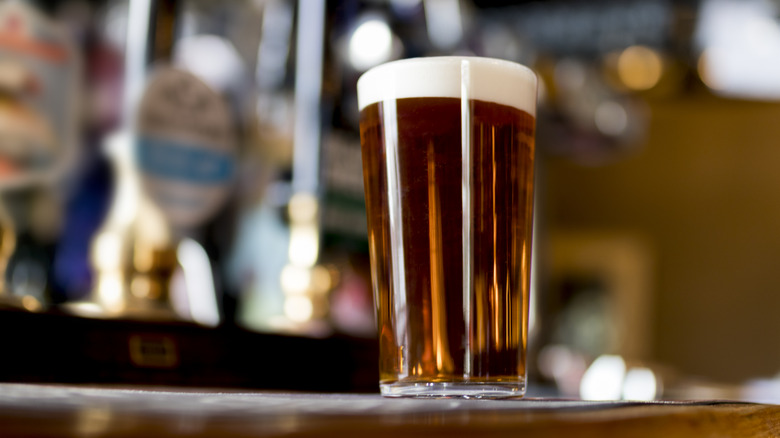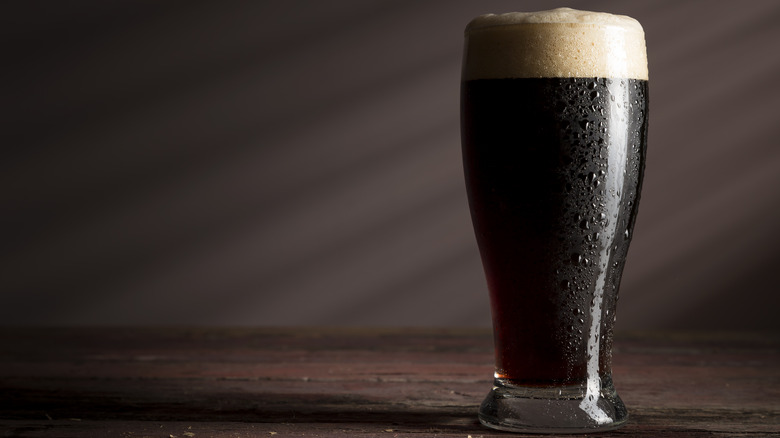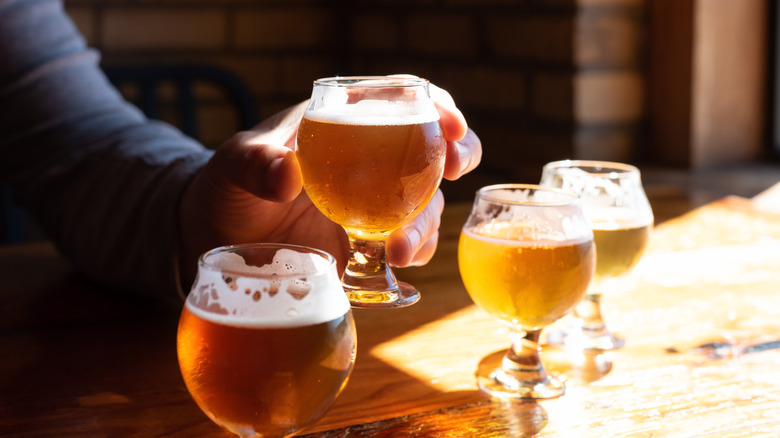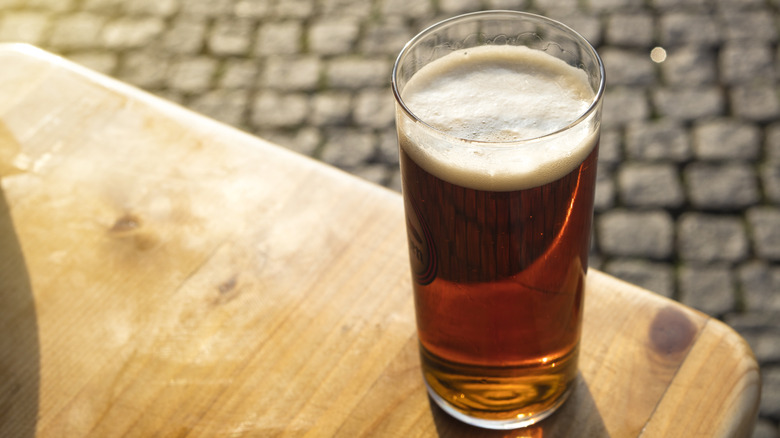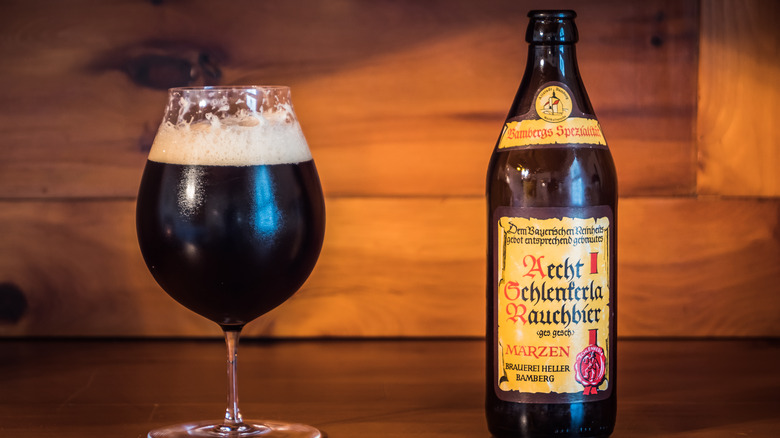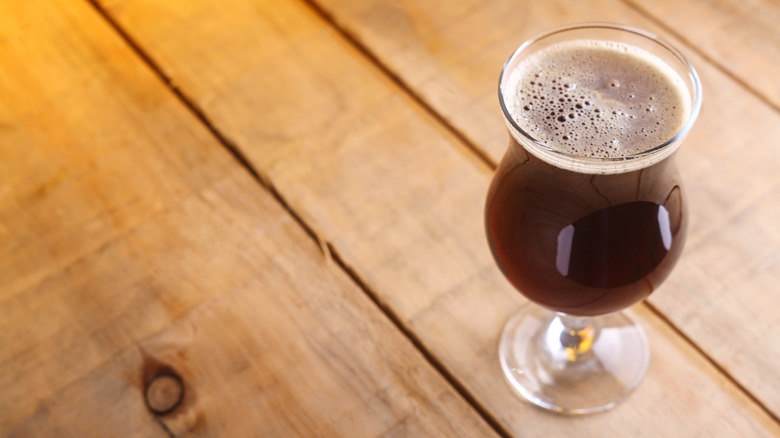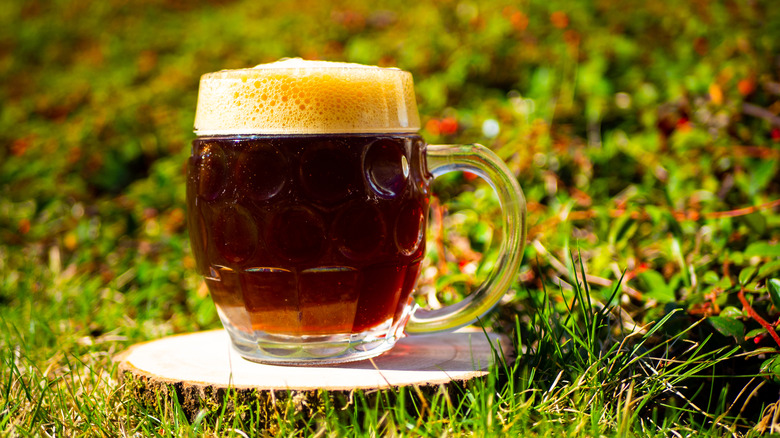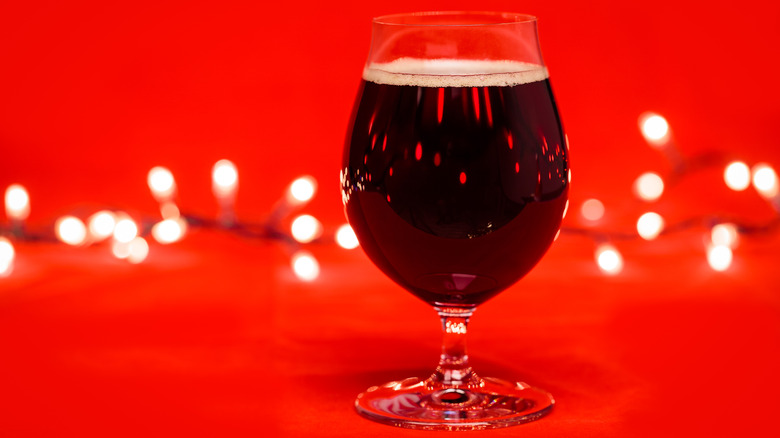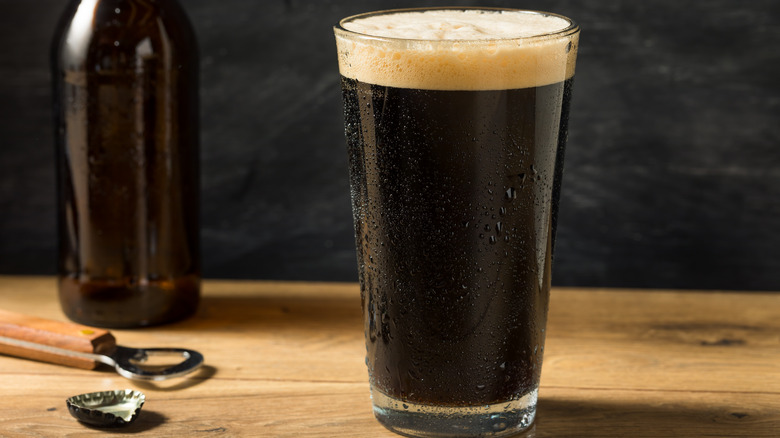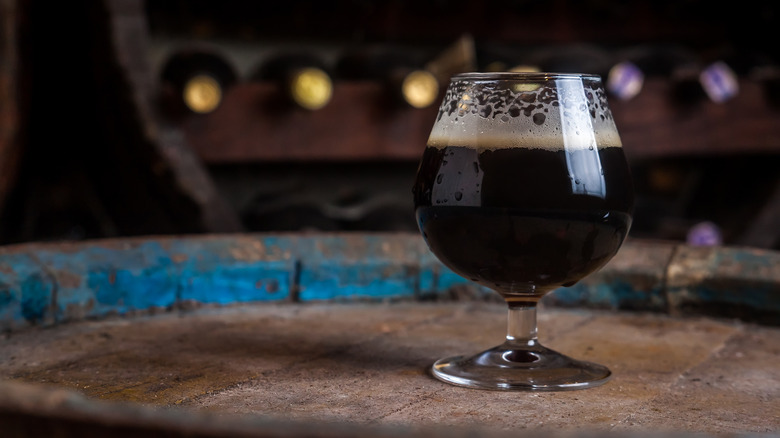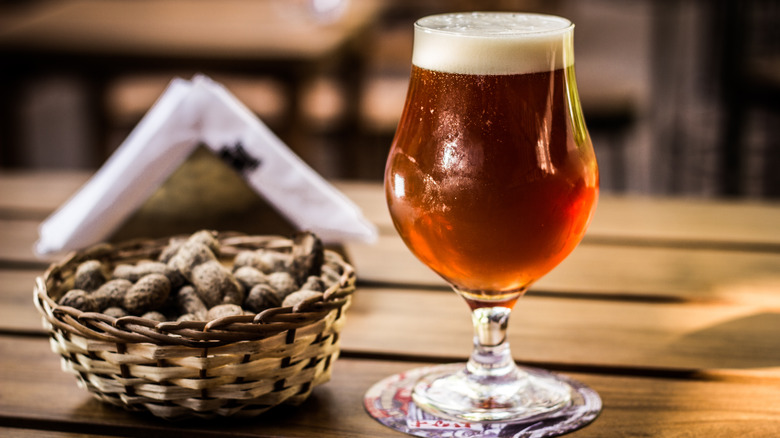The 12 Best Beer Styles For Winter
As the cold weather emerges and we look on to the winter months ahead, the preferred beers of summer seem to lose their purpose of vibrant refreshment. Beers like fruited sours, shandies, and juicy IPAs do not quite translate to the season where warmth is sought out as comfort as opposed to being conquered.
Instead, now is the time for malty richness, fuller bodies, and flavors of roasty goodness. While many beers on this list are best when adhering to traditional methods, some are at their best when experimentation with the aromas and flavors that bring us comfort from the cold are utilized and celebrated. Beers that fit into the winter months do not necessarily have to weigh you down with their indulgent depths and thickness. There are plenty of beers better suited for winter that are just as crisp and crushable as the ones you enjoy throughout the rest of the year. There is a beer out there for everyone no matter the season, and the winter months are no exception.
Red Ale
Red ales are a very unique beer style that is really in its own category. They are not quite the same as brown, dark, and or pale ales. The most comparable beer to a red ale is an American amber ale, but although they do share a similar color, are both medium-bodied, and both rich in flavor, they still are not interchangeable.
What makes a beer a red ale is its inclusion of kilned malts and roasted barley. Not only do these give the beer its recognizable color, but they also contribute to the roasted, toffee-like flavor notes and tan-hued head. These beers carry a medium body and have a crisp, low-hop bitterness at the finish of a super smooth, rich, malty mid-palate. There is a difference, however, between American red ales and Irish red ales. American red ales will be a bit drier and have more of a hop presence, while Irish red ales are more mellow. This is because Irish red ales are made using English hops, which are far less potent and bitter than their American-grown counterparts.
Red ales are excellent for the colder weather because of their rich malt and slightly roasted flavor but remain an easy-sipping beer that will not weigh you down. This crushability and robust flavor make red ales a great pairing for food like stews, roasts, or whatever gives you warmth and comfort during the winter. Red ales normally fall between 4% and 5% ABV.
Brown Ale
Brown ales date back to 17th century England and get their name because they were originally made using brown malt, (via Craft Beer). Brown ales were immensely popular until the use of cheaper pale malts became more widespread about a century later. Since then, brown ales are a less common beer style but one that is beginning to make a comeback in the modern craft beer scene.
Like red ales, brown ales claim their own category of beer simply due to their name coming from color alone, instead of by geography or alcohol content. Now, brown ales are made all over Europe and in the U.S., and what is often misconceived as a boring style of beer can actually be just as nuanced and rich as any other. In fact, the category of brown ales goes deeper than many people realize. Not only do brown ales from England taste different than ones made in Germany, Belgium, or any other country where different hops are utilized, but because the only requirement to be a brown ale is the color, the door is left open for experimentation.
Generally, brown ales have a malt-rich character providing an elongated finish that is subtly brought to a close with a low-hop bitterness. While many brewers are dishing out their own inspired takes on the traditional beer style, you can normally expect something straightforward and classic. They are robust, smooth, buttery, and a warming companion throughout the cold months.
Black Lager
Black lagers do not taste the way they look. Essentially, black lagers are just regular lagers made with roasted malts. Everything else remains the same. This means that black lagers, despite their intensely dark appearance, carry a light body with an exceptionally clean, crisp finish. That extra factor of roastiness goes a very long way, however, in making black lagers so unique, delicious, and well worth trying.
Black lagers originated in Germany, where they are referred to as Schwarzbiers, according to Vinepair. Now, black lagers have no geographical restrictions and have become a common beer found at breweries and other craft beer establishments. If you want a beer that has an ample depth of flavor, but you are not into the full-bodied, rich, and heavy beer styles commonly associated with the winter, then black lagers are for you. They bring that iconic lager crispness and simplicity with the added roasted malt that brings your beer into season while keeping things familiar and classic.
Imperial IPA
India Pale Ales are undoubtedly the most popular style of beer to come out of the craft beer boom. These hop-forward brews come in many different styles themselves, but one of the more common, best fit for winter IPAs is the Imperial IPA.
Basically, the term "imperial" when referring to beer is simply a reference to the beer's alcohol content, according to Draft Mag. You may have also heard of the term "double IPA," which is synonymous with Imperial IPA. These IPAs will normally have an ABV of at least 8%, some of which can even reach up to 10%. The reason Imperial IPAs have been included in this list is that the experimentation behind the style has produced some very unique, very specifically flavored beers. Fruit-flavored IPAs like cranberry or festive ones like gingerbread are like boozy treats that tie in perfectly with the foods and spirit of the winter season.
Even basic West Coast-style imperial IPAs have that piney, resin flavor to them that resembles the mountainous outdoors and the rustic, cozy vibes of winter. On the contrary, Hazy, or New England-style, IPAs are more juicy and fruity, and usually have profiles more suitable for the summertime. No matter what Imperial IPA you find that suits your needs when the weather gets cold, you can rest assured you will be sipping on a punchy brew with an extra kick of comfort to get you through it.
Altbier
Altbiers are another beer born in Germany, this one specifically from Dusseldorf, according to American Craft Beer. The name "altbier" translates to "old beer" in German. This is in reference to the style being made in a way that was common before contemporary brewing methods. Altbiers are a cross between a lager and an ale. They are made with ale yeast but fermented at colder temperatures like lagers.
There are also two different kinds of Altbiers. The one common in Dusseldorf has more of a hop presence from German hops or spalt hops, and altbiers made elsewhere have little to no hoppiness. These include darker or roasted malts and drink more like an ale than it does a crisp lager. No matter where your altbier comes from, its ABV should fall between 4% and 5%. Altbiers are another great beer to have with food and are very crushable brews with intense flavor. They are a great beer for those looking to try something new and are growing more and more common at American breweries. If you find the straightforwardness and reliability of German beers to your liking, altbiers will give you that familiarity and crispness with a subtly fuller body and a little more depth of flavor.
Rauchbier
Rauchbiers are one of the most unique styles of beer on this list. Another hailing from Germany, rauchbiers, or smoke beers, are made by smoking the malt before using it, per Kegerator. This style is actually one of the oldest in existence, dating back to before the invention of the drum kiln. Then, the only way to dry out malt for brewing was to keep it directly over a fire. Therefore, the smoky flavor found in Rauchbiers today was commonplace for every single beer made in that period of history.
After Daniel Wheeler invented the drum kiln in 1818, malts were able to be dried out without the use of fire, and the rauchbier grew less and less common. Now, two centuries later, there are merely nine remaining breweries in Bamberg, Germany that brew authentic rauchbiers, using the same methods dating all the way back to the 14th century.
Today, however, some craft breweries are realizing the wonderfully nuanced and one-of-a-kind flavor profile of rauchbiers and giving the style a go themselves. Despite their profound depth of robust flavor, they remain medium-bodied lagers that are crisp on their finish and easily drinkable. The smokiness in a rauchbier is really unlike anything you can get in another style of beer, comparable to the uniqueness of mezcal or Islay Scotch whisky. Some rauchbiers are smokier than others, of course, but even the most subtle exude those feelings of being warmed with a campfire.
Scotch Ale
Scotch ales encompass a variety of more specific beer styles, but they all share characteristics of rich maltiness, darker colors, and fuller-bodied. Scottish ales include light, heavy, export, and wee-heavy, which is the most common today. Each style is based on the beer's alcohol content, which ranges from under 3.5% to upwards of 6%, depending on the brewer, according to Hop Culture.
The reason for scotch ale's malt prominence is that Scotland's climate and soil are not ideal for the growing of hops. Therefore, there is little to no hop presence in Scottish ales. Instead, scotch ales, especially scotch wee-heavies, carry a very full body and have a very elongated finish that leads you all the way to the very next sip. Scotch wee-heavies are the most common scotch ale you will find at breweries today, and these are usually far boozier than traditional expressions of the beer, sometimes reaching close to 10% ABV.
Not only does this typically heightened alcohol content translate to the beer being great for keeping warm, but the rich, full-body of Scotch ales make them a decadent, boozy sipper to enjoy on a cold night either inside or out. Not every scotch ale will be the best accompaniment to a meal, as some can be considered as filling as a meal on its own, but the rich, dark maltiness of scotch ales does make them a great beer to cook with, the same way you might with a stout beer.
Bock
Bock beers are another traditional German beer dating back centuries, according to Hop Culture. Originally made in Einbeck in the 14th century, the beer eventually made its way to Munich, where the pronunciation of "Einbeck" was misunderstood and continued on as "Ein Bock," which translates to "billy goat." Centuries later, if you find a bock beer today, chances are the label on it will feature some symbol of a goat, a direct result of this misinterpretation.
In Germany, bock beers are usually reserved for celebratory occasions. In fact, Bavarian monks used to brew and store bock beers during the winter to be savored when the weather brightened in the springtime. This aging period is what settles down the intense flavors of the beer, which are much more presentable, balanced, and enjoyable when the time finally comes to crack one open.
Bock beers typically fall around the 6% ABV mark and have a very low hop bitterness and carbonation, Hop Culture continues. Bocks are a strong, mellow beer with an exceptionally smooth mouthfeel and drawn-out finish. One common iteration of a bock beer you probably have come across before is the Sam Adams Winter Lager. This Americanized version is not quite the same as bock made in Germany, but the general flavor and body are definitely a comparable reference point.
Doppelbock
Doppelbocks are a subcategory of bock beers and are essentially an enhanced version of the original. As the bock beers of Einbeck gradually made their way into the Bavaria region, the monks of St. Francis of Paula in Berlin took on the beer style and made it their own in the 17th century, according to Beer Connoisseur. The monks actually began strengthening the original bock style to sustain themselves through extended fasts during the religious season of lent. This meant an even fuller body, even more alcohol, and even more richness. Doppelbocks quickly came to be referred to as "liquid bread" because of their more substantial heartiness.
Today, there are both Helles, or "pale," and dark doppelbocks. Helles doppelbocks typically utilize Pils or Vienna malts, which is why they are lighter and paler in appearance and not as rich. The more common, darker doppelbocks are typically made with Munich malts which contribute to that rich maltiness that seemingly has so bottom. Doppelbocks are great for winter simply because of their decadence in every category. Their potent alcohol, body, aroma, and flavor all contribute to this style of beer being a must-have when the weather turns. Doppelbocks will normally have an alcohol content of at least 7%, but they really do not taste like it because of the depth of their profile.
Porter
It is a common misconception that porters and stouts are interchangeable, but they are not. While they appear the same and share similar flavor notes and bodies, there are multiple differences between the two.
First is the difference in geography. Porters originated in London, England, and came about with the discovery of dark malts' ability to combat the very mineral-heavy water, according to Beer & Brewing. Another difference is a slight one in the porter's body, which, while still a fuller body, is not quite as thick as the typical stout. Instead, porters' bodies are generally a tad lighter and have a slightly sharper finish. Also, porters do not utilize roasted malts, whereas stouts do. This is another contributor to porters' slightly lighter bodies, plus, their less formidable flavor profiles. The flavor notes of chocolate and coffee are present in both, but porters are typically more subtle and make for a more approachable beer.
Another difference between the two is the varieties they come in. Porters can really only be found in the imperial or standard form, with an ABV of about 10% and 5% respectively. Stouts, on the other hand, come in far more styles. Regardless, of its differences from its closely related friend, porters are a quintessential wintertime brew. Their notes of chocolate and coffee fit right into the comforting nature of the colder months but remain very approachable and drinkable dark beers for those yet to dive into the realm.
Stout
As mentioned above, as opposed to porters, stouts have a fuller body, roasted malt, and come in many different varieties. Plus, as Beer and Brewing notes, the origin of stout beers is credited to Ireland, but this beer style goes far beyond Guinness.
Just like the India Pale Ale, modern brewers are having themselves a field day with stouts. Types of stouts include Irish dry, milk, oatmeal, oyster, pastry, coffee, or barrel-aged, to name some. The most common stout you will find nowadays and the one that lends itself to the most customization is Imperial Stouts.
Again, this is just in reference to the beer's alcohol content. In the world of imperial stouts, however, that alcohol content reaching as much as 12% is not at all uncommon. In fact, it's rather encouraged and celebrated. This is a big reason why stouts are so great for the winter months apart from their full body, creamy texture, and decadent flavor profile. Imperial stouts can be flavored with pretty much anything, so they are a great vehicle for brewers to ring in those seasonal flavors into a decadent, boozy beer.
Barley Wine
According to Craft Beer, the origins of barley wine are understood to be actual beers strengthened by wine, but the barley wine ales made today are simply English-style beers with heightened alcohol content, the same as wine. Also like wine, barley wines are aged and their character evolves over time. Basically, barleywines are England's version of Scotch Wee-Heavies or German Doppelbocks, only stronger. They have, however, become a common beer style in the American craft beer scene.
Despite having ABVs often up to 12%, barley wines are so rich in their English malt and hop that they really do just taste like very robust beers. The flavor profile of barley wines is driven by toffee and fruit which are pleasantly palatable on their way to a sharp finish from the strong English hops. It is no wonder barley wines made this list, as their richness, sturdiness, and complexity make them the perfect sipper next to a fireplace, both of which are sure to help you feel nice and toasty.
